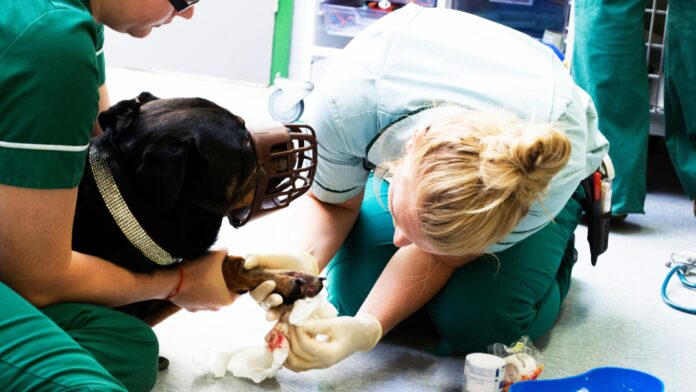Caring for your dog’s wounds properly is essential to ensure a speedy recovery and prevent infections. This article will guide you step-by-step on how to clean a dog wound, ensuring that you can handle the situation with confidence and care.
ALSO READ: Ten Signs Your Dog Is Dying: Recognizing End-of-Life Symptoms

Understanding the Importance of Cleaning Dog Wounds (how to clean a dog wound)
When your dog gets injured, cleaning the wound promptly and effectively is crucial. It helps prevent infections and promotes faster healing. Neglecting a wound can lead to complications that might require more extensive veterinary care.
Types of Dog Wounds
Abrasions
Abrasions are superficial injuries that occur when the skin is scraped against a rough surface. These wounds are usually minor but can become infected if not properly cleaned.
Lacerations
Lacerations are deep cuts often caused by sharp objects such as glass or metal. These wounds can be more serious and require careful cleaning and sometimes stitching.
Punctures
Puncture wounds are caused by sharp, pointed objects such as nails or bites from other animals. These wounds can be deceptive, appearing small on the surface but penetrating deeply, posing a higher risk of infection.
Incisions
Incisions are clean cuts typically resulting from surgery or accidents with sharp objects. These wounds usually heal well with proper care but require immediate attention to prevent infection.
Gathering the Necessary Supplies
Before you start, make sure you have all the necessary supplies. Here’s a list of items you’ll need to clean a dog wound:
- Sterile saline solution or clean water
- Antibacterial soap or pet-safe antiseptic
- Clean cloth or gauze
- Tweezers (if there are foreign objects in the wound)
- Antibiotic ointment
- Bandages or wound dressing
Step-by-Step Guide on How to Clean a Dog Wound
1. Assess the Wound
Before you begin cleaning, assess the severity of the wound. If the wound is deep, bleeding heavily, or if your dog is in significant pain, it is best to consult a veterinarian immediately. For minor wounds, you can proceed with home cleaning.
2. Calm Your Dog
It is essential to keep your dog calm and still during the cleaning process. You can use a muzzle if necessary, or have someone help you hold your dog gently.
3. Clean Your Hands
Before touching the wound, wash your hands thoroughly with soap and water to prevent introducing bacteria to the wound site.
4. Rinse the Wound
Use the sterile saline solution or clean water to gently rinse the wound. This helps remove dirt and debris from the wound site. Avoid using hydrogen peroxide or alcohol as they can damage the tissue and delay healing.
5. Remove Foreign Objects
If there are any visible foreign objects in the wound, use tweezers to carefully remove them. Be gentle to avoid causing further injury to your dog.
6. Clean the Wound
Apply a small amount of antibacterial soap or pet-safe antiseptic to the wound. Use a clean cloth or gauze to gently clean the area around the wound. Make sure to rinse off any soap or antiseptic thoroughly with clean water.
7. Apply Antibiotic Ointment
After cleaning the wound, apply a thin layer of antibiotic ointment to help prevent infection and promote healing.
8. Bandage the Wound
If the wound is in a location that can be bandaged, use a clean bandage or wound dressing to cover it. This protects the wound from dirt and your dog from licking it. Make sure the bandage is not too tight, as it can restrict blood flow.
Monitoring the Wound
1. Check for Signs of Infection
Keep an eye on the wound for signs of infection, such as redness, swelling, pus, or an unpleasant odor. If you notice any of these signs, contact your veterinarian immediately.
2. Change Bandages Regularly
If you have bandaged the wound, change the bandage regularly to keep the area clean and dry. Follow your veterinarian’s instructions on how often to change the bandage.
3. Prevent Licking and Chewing
Dogs often try to lick or chew their wounds, which can introduce bacteria and delay healing. Use an Elizabethan collar (cone) to prevent your dog from reaching the wound.
When to Seek Veterinary Care
While minor wounds can be managed at home, certain situations require professional veterinary care:
- The wound is deep or gaping
- There is heavy bleeding that does not stop
- The wound is located on the face, neck, or near joints
- Your dog shows signs of severe pain or distress
- The wound does not show signs of healing within a few days
Recognizing Severe Wounds
Seek veterinary care for deep lacerations, puncture wounds, or any wound that is not healing properly. Severe wounds may require stitches or more advanced medical treatment.
Symptoms That Need Professional Attention
If your dog shows signs of persistent redness, swelling, fever, or significant pain, it’s important to seek veterinary help. These symptoms may indicate an infection or other complications.
What to Expect at the Vet
During a veterinary visit, the vet will examine the wound, clean it thoroughly, and may apply stitches or other treatments as needed. They will also provide you with aftercare instructions and may prescribe antibiotics or pain relief medication.
Preventing Future Injuries
1. Regular Grooming
Keeping your dog’s nails trimmed and fur clean can help prevent injuries. Matted fur can hide wounds and make them worse.
2. Safe Environment
Ensure your dog’s environment is safe and free of sharp objects or hazardous materials that could cause injuries.
3. Supervised Play
Monitor your dog’s playtime, especially if they are interacting with other dogs or playing with toys that could cause injury.
Conclusion
Knowing how to clean a dog wound properly is an essential skill for any pet owner. By following these steps, you can help your dog heal quickly and prevent complications. Always keep an eye on the wound and seek veterinary care when necessary.
FAQs
1. Can I use hydrogen peroxide to clean my dog’s wound?
No, hydrogen peroxide can damage tissue and delay healing. It is better to use sterile saline solution or clean water for rinsing the wound.
2. What if my dog keeps licking the wound?
Use an Elizabethan collar (cone) to prevent your dog from licking the wound. Licking can introduce bacteria and delay healing.
3. How often should I change the bandage on my dog’s wound?
Change the bandage regularly, at least once a day, or as directed by your veterinarian, to keep the wound clean and dry.
4. When should I take my dog to the vet for a wound?
If the wound is deep, bleeding heavily, or shows signs of infection (redness, swelling, pus, or an unpleasant odor), seek veterinary care immediately.
5. Can I use human antibiotic ointment on my dog’s wound?
Yes, you can use over-the-counter antibiotic ointments like Neosporin, but it is always best to consult your veterinarian before applying any medication.


